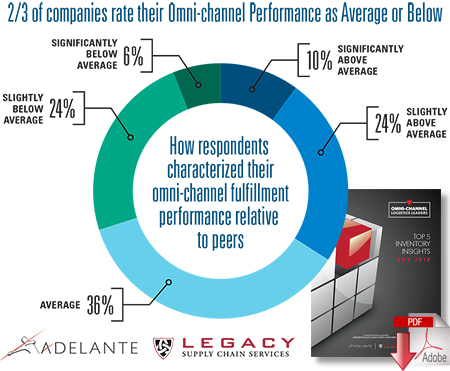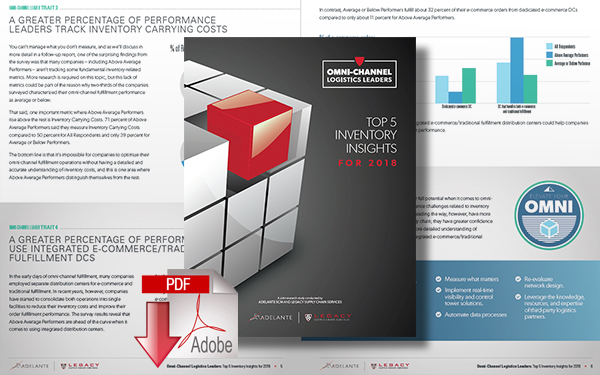Increase Inventory Visibility across Your Supply Chain and Optimize Omni-Channel Fulfillment

The key to meeting and exceeding inventory efficiency across multiple channels is to improve your company’s omni-channel fulfillment performance, starting with inventory visibility.
Omni-Channel Fulfillment
It’s a challenge with which many retailers, wholesalers, and distributors are likely familiar: maintaining accurate, up-to-date inventory across multiple channels and supply chain segments.
With an ever-growing collection of IoT-enabled devices from which to browse, research and purchase retail products, consumer expectations are at an all-time high - expectations that typically include immediate service and a seamless customer experience.
The key to meeting and exceeding these expectations is to improve your company’s omnichannel fulfillment performance, starting with inventory visibility.
Inventory visibility along the supply chain provides numerous benefits:
- More accurate forecasting
- Smarter resource allocation
- Increased efficiency
- Reduced stock levels
- Increased demand fulfillment
- Greater supply chain transparency
According to a recent research survey on inventory management conducted by LEGACY Supply Chain Services in partnership with Adelante SCM, the majority of businesses experience challenges with inventory visibility and optimization.
Two-thirds of respondents characterized their omnichannel performance (relative to peers in their industry) as average or below, with 30 percent characterizing it as below average.
Download Omni-Channel Logistics Leaders: Top 5 Inventory Insights
Respondents who characterized their performance as slightly above or significantly above average also reported having greater confidence in their inventory accuracy across supply chain nodes.
Here, we’ll explore possible methods to increase inventory visibility across supply chain nodes to improve your business’s overall omnichannel performance.
Inventory at Stores
According to research from the Ecommerce Foundation, 88 percent of consumers research products online before they make an in-store purchase - a statistic that speaks to just how much technology has transformed the buyer’s journey.
Due to this, it’s imperative that retailers’ online storefronts be consistent with their brick-and-mortar locations.
Consider, for example, that a customer goes to your company’s website to see whether a particular product is available at their local storefront.
Once they’ve confirmed that it is, they go to the store in person to pick it up, only to be told by a sales associate that the item is currently out of stock.
While it’s possible that the product truly is out of stock, it’s also possible that your inventory management system lacks the real-time visibility to accurately indicate how many items are left on the shelf.
Either way, this lack of inventory visibility has cost the consumer valuable time and, potentially, will make them less likely to return to your store in the future.
That’s why it’s imperative that businesses implement inventory management software that provides real-time inventory tracking and integrates with back-office systems, as well as supplier and third-party logistics systems, for end-to-end visibility and data accuracy.
With the right inventory management system, you can:
- Ensure that both retail employees and your website have an accurate count of how much product at any given point in time at any given site
- Quickly adapt to shifts in demand that might require fulfillment from alternate distribution locations
- Gain insight into your inventory to see which products are performing best
Read: 9 Omni-Channel Logistics Challenges Facing Your Supply Chain
Inventory at Distribution & Fulfillment Centers
Although suppliers, manufacturers, and third-party logistics (3PL) providers are each responsible for a different part of the supply chain, they have the same needs with regard to inventory visibility.
Visibility into your manufacturer’s facility or your supplier or 3PL partner’s distribution and fulfillment centers makes it possible to assess product velocity over the course of the average business cycle, adjust inventory level according to demand, perform quality control assurance, and more efficiently allocate resources.
This inventory management visibility is essential to ensure that your company has enough products to satisfy customer demand, whether in-store or online.
A warehouse management system (WMS) helps suppliers, manufacturers and 3PLs provide this visibility by enabling them to control and direct warehouse operations - such as monitoring product quantities, cycle counting, picking, packing and more - from a single interface.
A WMS also uses data to provide third-party vendors with an assessment of warehouse efficiency and recommendations on how to improve warehouse operations.
As a result, retailers and wholesalers gain greater visibility into their inventory, which enables them to develop a more efficient order fulfillment process.
Inventory in Transit
The best way to reduce the number of returns to your company is to ensure that the right product is delivered to the right destination, every time.
This is a lofty goal, to be sure, but one made more attainable with inventory visibility into products in transit. If you can track, in real-time, which products are being transported and to which destinations, you can ensure that an item that was supposed to ship to a consumer in New York City doesn’t mistakenly end up in the hands of a consumer in Los Angeles or London.
A transportation management system (TMS) is essential to achieve that visibility. Simply put, a TMS is a software system designed to manage transportation operations.
Some of the core functionalities of a good TMS include real-time visibility into shipping processes, status tracking, and up-to-the-minute reporting. These capabilities help retailers, wholesalers and distributors guarantee that the right item is en route to the right customer.
In addition to providing inventory visibility into items in transit, a TMS can automate transportation margin management, improve internal business processes, provide analysis into transportation costs and measure key business performance indicators.
When leveraged by the right 3PL provider, a TMS can also optimize transportation through consolidation tactics and strategies to identify low-cost carriers.
With today’s high expectations around your company’s omnichannel fulfillment performance, having the right tools to boost inventory visibility is more essential than ever.
Read: Industry Study looks at Inventory Management as a Critical Function within Omni-Channel Logistics
Download the Research Study
Omni-Channel Logistics Leaders: Top 5 Inventory Insights
Based on data collected from nearly 100 companies actively engaged in retail, manufacturing, and logistics services, this research paper has provided several valuable insights ranging from current challenges & best practices, characteristics of companies considered high performers, and opportunities for improvement from companies lower on the omnichannel performance curve. Download Now!
Article Topics
LEGACY Supply Chain Services News & Resources
Outsourcing eCommerce Fulfillment to a 3PL Rapidly Improve the Performance of Your Warehouse Logistics 20 Warehouse & Distribution Center Best Practices for Your Supply Chain Warehouse Contingency Planning Template 7 Last Mile Logistics Delivery & Ecommerce Trends You Don’t Want to Overlook Increase Inventory Visibility across Your Supply Chain and Optimize Omni-Channel Fulfillment Omni-Channel Logistics Leaders: Top 5 Inventory Insights More LEGACY Supply Chain ServicesLatest in Supply Chain
TIm Cook Says Apple Plans to Increase Investments in Vietnam Amazon Logistics’ Growth Shakes Up Shipping Industry in 2023 Spotlight Startup: Cart.com is Reimagining Logistics Walmart and Swisslog Expand Partnership with New Texas Facility Nissan Channels Tesla With Its Latest Manufacturing Process Taking Stock of Today’s Robotics Market and What the Future Holds U.S. Manufacturing Gains Momentum After Another Strong Month More Supply Chain
















